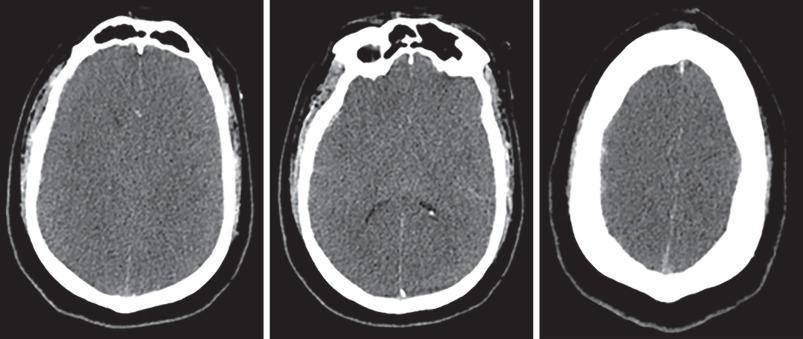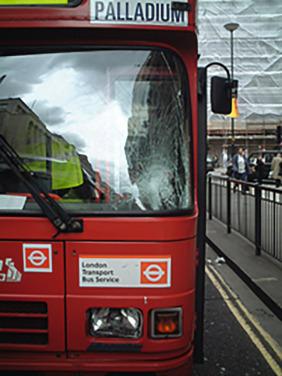Physical Address
304 North Cardinal St.
Dorchester Center, MA 02124
Our role as clinician-scientists is to minimize secondary brain injury, meaning evolving pathologies from the moment of impact.
Hence, if the impact has not killed the patient, there is opportunity to intervene and minimize further morbidity or mortality.
There are many types of traumatic brain injuries, but because we cannot diagnose on scene, they are all managed identically. On-scene diagnostics may enable brain injury–specific therapies to be targeted in future.
Hypoxia is still a common, and easily minimizable, secondary injury.
If you are going to make a difference in brain injury, the time to do it is before the brain injury has evolved—that is, during the hyperacute/prehospital phase.
Traumatic brain injury (TBI), severe enough to lead to mortality or hospitalization, affects more than 10 million people annually. Sixty percent follow road traffic injuries, and by 2020, the World Health Organization predicts TBI will surpass many diseases to become the major cause of death and disability. The escalating prevalence of trauma, especially in resource-poor countries, means that the number of TBI victims and the burden on families and society that this creates will continue to swell. The increasing elderly population, falls, and anticoagulation use is shifting TBI from being a disease of young men to a common disease of the elderly.
It is in the domain of health policy and lawmakers, through policies such as road and vehicle standards, the use of helmets, and so on, that primary brain injury can be minimized. It is, however, the role of scientists and clinicians to minimize the effects of secondary brain injury, be that through the development of techniques and drugs to reduce evolving injury or through the development of systems to deliver specific treatments in a hyperacute manner. Neural and cardiac tissue has short survivable ischemic time and does not recover, hence the traditional critical care research domains utilizing monitoring tools and techniques to improve “penumbra” areas on days following injury could probably be bettered by instituting hyperacute treatment modalities that actually stop neuronal/cardiac loss in the first few minutes after an event. If you are not dead when the emergency services arrive, there is an interventional opportunity and you should not die—it is our ability to control secondary injury that determines this outcome.
The Brain Trauma Foundation has published and revised “Pre-Hospital Management” of TBI guidelines ( https://braintrauma.org/guidelines/pre-hospital#/ ). These are a solid basis from which the advances in this chapter are made.
The most common causes of head injuries are road traffic incidents, falls, and assaults. Although contact sport injuries attract attention for concussion and return-to-play reasons, they are not usually immediately life threatening.
The mechanism of injury and patient features can help to predict underlying brain injury. Direct blows to the head are more likely to result in skull fractures and extradural hematoma. Sudden deceleration, as may occur to a motorcyclist's head inside a helmet, are associated with shearing injuries, most likely to cause subdural hematoma and diffuse axonal injury.
In nonwar zones, penetrating brain injuries are comparatively rare. The exception is in the United States, where firearms cause 12% of all TBIs and an estimated 35% of all TBI deaths. In the 25- to 34-year-old age range, it is a leading cause of TBI. Ninety percent are fatal with many dying prior to hospitalization ( http://www.aans.org/Patients/Neurosurgical-Conditions-and-Treatments/Gunshot-Wound-Head-Trauma ). This relates to the use of firearms in suicide (the most common suicide mechanism in males) and gang feuds.
Dispatching the most appropriate resource to TBI victims is key to optimal management. If a patient has sustained a significant mechanism (eg, a fall from more than two stories or ejection from a car) or has an appreciably reduced level of consciousness, he or she may well benefit from advanced trauma care (as discussed later in this chapter) in addition to a statutory ambulance response.
Although commonly forgotten, one of the first responses following a blow to the head is a period of apnea. Although a well-known phenomenon in animal TBI experimentation, because clinicians are rarely present at the time of TBI, it is underappreciated in human injury. Greater energy transfer results in longer apnea, which appears to be exacerbated by alcohol.
A catecholamine surge also occurs in animal models of impact brain apnea (IBA), followed by cardiovascular collapse. This is seen in approximately 13% of isolated human head injuries and can easily be mistaken for hypovolemia.
Impact brain apnea together with the loss of airway associated with reduced consciousness causes either death prior to emergency medical service (EMS) arrival or hypoxic brain injury if delayed treatment is subsequently provided. The management of both requires bystander intervention. Training children and the public and alerting those who are trained to such events are the best techniques for minimizing hypoxic damage prior to EMS management ( Fig. 63.1 ).

Hypoxia itself can result in both cerebral and retinal microhemorrhages. This can be misinterpreted as diffuse axonal imaging (DAI) on subsequent magnetic resonance imaging, hence it is important to consider the mechanism of injury. The volume of microhemorrhage appears to correlate with neurologic outcome following abusive head trauma (nonaccidental injury/shaken baby syndrome).
It is vital that hyperacute pathologic processes are appreciated so that correct treatments can be developed. There is some evidence that rapid reoxygenation can worsen microhemorrhage formation, but this needs further study.
Concussion is a poor term often used in relation to the transient neurologic disturbances following relatively minor TBI. It is not the focus of this chapter, but assessment can be made with tools such as the Sports Concussion Assessment Tool (SCAT 3) supporting decisions around “return to play.” It must be remembered that players may occasionally have more significant injury requiring intervention. And despite the considerable media attention this issue has received, many more people are “concussed” through domestic, occupational, and traffic accidents than sports.
Managing the scene of an incident (in particular, scene safety) is the immediate priority on EMS arrival. While approaching the patient, signs as to the mechanism and force vectors of injury can often be evaluated by “reading the wreckage.” A vehicle with a bull's-eyed windshield ( Fig. 63.2 ) and a patient who is a considerable distance away implies a head injury with significant force vectors, and this must be taken into account if the patient seems surprisingly well. The technique of assessing and concurrently managing the patient with a standard airway, breathing, circulation framework is appropriate; however, it is personalized “meaningful interventions” that improve the patient without delaying transfer to definitive care that should be the primary focus. Assessment of a patient's Glasgow Coma Scale (GCS) and pupillary response is vital to establish clues as to the degree of underlying injury and how to proceed with management.

Cervical spine protection has been the mainstay of Advanced Trauma Life Support (ATLS) teaching and remains critical in US national guidelines. Traditionally this has been triple immobilization through the application of a collar, sandbags, and tape. However, the benefits have been questioned for some time, with the value of the cervical collar in addition to blocks and tape being specifically questioned. The risks of spinal immobilization—in particular, the risks of aspiration, pressure sores, and raised intracranial pressure (ICP) —have caused some countries to revise their guidelines. Some reviews have been critical of cervical collars, whereas others still recommend their use with blocks and tape. In Norway the use of the lateral position to protect the airways does not appear to be associated with increased spinal injury. The Australian and New Zealand Resuscitation councils no longer recommend the use of semirigid collars.
It is often difficult to establish if patients are agitated because this is their nature, because they are under the influence of drugs/alcohol, or because of their head injury. Gaining control of the situation to enable better assessment is vital. If verbal reassurance does not result in compliance and TBI is likely to be a cause, then sedation (eg, with midazolam or ketamine) may be required. This will commonly reduce the patient's level of consciousness and may subsequently necessitate intubation, hence those administrating such drugs have to be competent in advanced airway management. However, given that the patient will need to lie still for computed tomography (CT), this treatment can be considered in order to expedite an expected clinical course. In this high-risk situation, not intervening can result in patient harm, but intervening could potentially compromise the patient's airway. There is a paucity of literature studying the optimal management of such patients, therefore a patient-specific assessment together with the skill sets and resources of the clinician are necessary to form a risk analysis in each case.
Of note, despite long-held concerns, ketamine does not appear to increase ICP significantly and has the benefits of possibly serving as a neuroprotectant as well as maintaining airway reflexes.
Patients who have suffered traumatic brain injury often have concurrent facial injuries. This can cause airway compromise, and simple maneuvers can help reduce the significantly increased mortality hypoxia can contribute post TBI. Jaw thrust and simple naso/oropharyngeal airways can maintain airway, often during transportation or while an intubation kit is assembled if resources/skills enable this approach. Although some guidance may advise against the use of nasopharyngeal airways (NPA), a risk assessment should be made, as maintenance of airway should take priority over small risk or intracranial misplacement. The patient's mouth should be opened to ensure the NPA passes behind the soft palate into the oropharynx. Torrential facial bleeding may benefit from the creation of a construct comprising nasal balloon tamponade, bite blocks and a cervical collar.
Many studies in the literature demonstrate that prehospital intubation of head-injured patients increases mortality. Davies and coworkers demonstrated in San Diego that EMS intubation for TBI resulted in increased mortality. Analysis of such studies needs careful interpretation, separating prehospital and in-hospital intubation from intubation by less trained and more trained technicians. The meta-analysis performed by von Elm and colleagues reviewed the literature up to 2007 and concluded that there was no evidence of benefit from prehospital intubation.
We need to be extremely clear about reasons for prehospital intubation. There are two common reasons in isolated TBI:
Airway compromise—for example, low GCS (<8), tongue fallen back, laryngeal injury
Expected clinical course—for example, the agitated patient (GCS 12−14)
Patients who have suffered TBI are at high risk of vomiting and aspiration. Commonly, large quantities of alcohol coexist and exacerbate this condition. The reason for intubating those with a GCS < 8 is to maintain and protect the airway during transfer. The reason for intubating the agitated group is to do the same and also to gain control and to safely and more rapidly transfer these patients to the hospital for imaging. The risks/benefits relate largely to the training, governance, and safety of those undertaking the procedure rather than to the procedure itself.
In the UK, well-governed, doctor-led advanced medical services have demonstrated that prehospital intubation is a safe procedure. A statistically improved Glasgow Outcome Score has been demonstrated with intubation by well-trained paramedics in Australia. A small study demonstrated that approximately one-third of agitated patients were found to have an abnormal CT scan.
Induction agents are commonly debated, and in the UK there has been a trend away from thiopentone/etomidate (as sedatives) and suxamethonium (as paralytic) followed by morphine and midazolam, to fentanyl, ketamine, and nondepolarizing paralytics such as rocuronium. In a small study, the newer drug combination has been demonstrated to improve laryngoscopy.
It should be noted that the considerations for prehospital intubation differ from those for in-hospital intubation, where optimization of conditions occurs naturally. The process requires training and significant governance. For example, the patient should (ideally) be off the floor, placed to allow 360-degree access to the head (eg, not in the back of an ambulance), and a preprocedure briefing and checklists should be included.
Become a Clinical Tree membership for Full access and enjoy Unlimited articles
If you are a member. Log in here